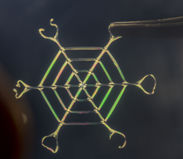Green method developed for making artificial spider silk
A team of architects and chemists from the University of Cambridge has designed super-stretchy and strong fibres which are almost entirely composed of water, and could be used to make textiles, sensors and other materials. The fibres, which resemble miniature bungee cords as they can absorb large amounts of energy, are sustainable, non-toxic and can be made at room temperature.

Myriams-Fotos; pixabay.com; CC0
This new method not only improves upon earlier methods of making synthetic spider silk, since it does not require high energy procedures or extensive use of harmful solvents, but it could substantially improve methods of making synthetic fibres of all kinds, since other types of synthetic fibres also rely on high-energy, toxic methods.
Spider silk is one of nature's strongest materials, and scientists have been attempting to mimic its properties for a range of applications, with varying degrees of success. "We have yet to fully recreate the elegance with which spiders spin silk," said co-author Dr Darshil Shah from Cambridge's Department of Architecture.
The fibres designed by the Cambridge team are "spun" from a soupy material called a hydrogel, which is 98% water. The remaining 2% of the hydrogel is made of silica and cellulose, both naturally available materials, held together in a network by barrel-shaped molecular "handcuffs" known as cucurbiturils. The chemical interactions between the different components enable long fibres to be pulled from the gel.
The fibres are pulled from the hydrogel, forming long, extremely thin threads - a few millionths of a metre in diameter. After roughly 30 seconds, the water evaporates, leaving a fibre which is both strong and stretchy.
"Although our fibres are not as strong as the strongest spider silks, they can support stresses in the range of 100 to 150 megapascals, which is similar to other synthetic and natural silks," said Shah. "However, our fibres are non-toxic and far less energy-intensive to make."
The fibres are capable of self-assembly at room temperature, and are held together by supramolecular host-guest chemistry, which relies on forces other than covalent bonds, where atoms share electrons.
"When you look at these fibres, you can see a range of different forces holding them together at different scales," said Yuchao Wu, a PhD student in Cambridge's Department of Chemistry, and the paper's lead author. "It's like a hierarchy that results in a complex combination of properties."
The strength of the fibres exceeds that of other synthetic fibres, such as cellulose-based viscose and artificial silks, as well as natural fibres such as human or animal hair.
In addition to its strength, the fibres also show very high damping capacity, meaning that they can absorb large amounts of energy, similar to a bungee cord. There are very few synthetic fibres which have this capacity, but high damping is one of the special characteristics of spider silk. The researchers found that the damping capacity in some cases even exceeded that of natural silks.
"We think that this method of making fibres could be a sustainable alternative to current manufacturing methods," said Shah. The researchers plan to explore the chemistry of the fibres further, including making yarns and braided fibres.
Original publication
Original publication
Yuchao Wu, Darshil U. Shah, Chenyan Liu, Ziyi Yu, Ji Liu, Xiaohe Ren, Matthew J. Rowland, Chris Abell, Michael H. Ramage, and Oren A. Scherman; "Bioinspired supramolecular fibers drawn from a multiphase self-assembled hydrogel"; PNAS; 2017
Topics
Organizations
Other news from the department science

Get the chemical industry in your inbox
By submitting this form you agree that LUMITOS AG will send you the newsletter(s) selected above by email. Your data will not be passed on to third parties. Your data will be stored and processed in accordance with our data protection regulations. LUMITOS may contact you by email for the purpose of advertising or market and opinion surveys. You can revoke your consent at any time without giving reasons to LUMITOS AG, Ernst-Augustin-Str. 2, 12489 Berlin, Germany or by e-mail at revoke@lumitos.com with effect for the future. In addition, each email contains a link to unsubscribe from the corresponding newsletter.




























































